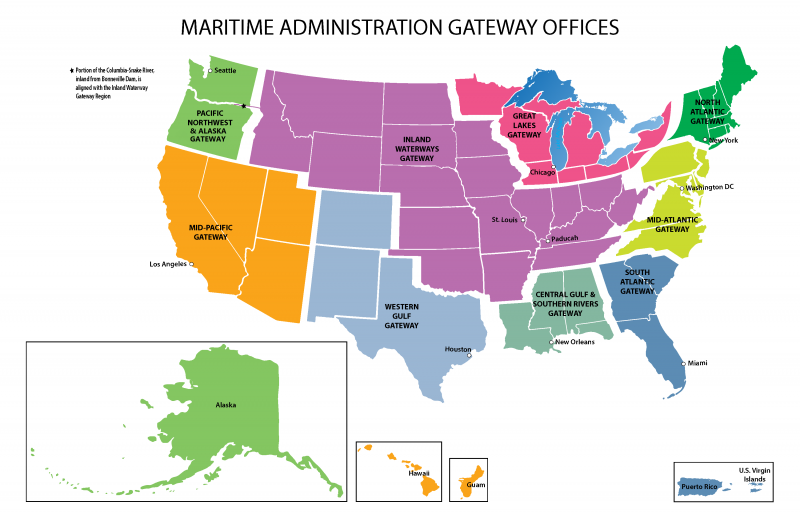500
2022 Port Infrastructure Development Program (PIDP) Notice of Funding Opportunity (NOFO) Amendment 1
Community Development Zones & Historically Disadvantaged Communities
A Federally designated Community Development Zone is a qualified Opportunity Zone, Empowerment Zone, Promise Zone, or Choice Neighborhood.
Applicants can find additional information about each of the designated zones at the sites indicated below:
Opportunity Zones: (https://opportunityzones.hud.gov/)
Empowerment Zones: (https://www.hud.gov/hudprograms/empowerment_zones)
Promise Zones: (https://www.hud.gov/program_offices/field_policy_mgt/fieldpolicymgtpz)
Choice Neighborhoods: (https://www.hud.gov/program_offices/public_indian_housing/programs/ph/cn)
A "Historically Disadvantaged Community" is defined for the PIDP program in the 2022 NOFO, consistent with OMB's Interim Guidance for the Justice40 Initiative. A project is located in a Historically Disadvantaged Communities if:
(1) the project is located in certain qualifying census tracts, identified in this table; OR
(2) the project is located on Tribal land; OR
(3) the project is located in any territory or possession of the United States.
Additionally, DOT is providing a mapping tool to assist applicants in identifying whether a project is located in a Historically Disadvantaged Community at https://usdot.maps.arcgis.com/apps/dashboards/d6f90dfcc8b44525b04c7ce748a3674a. Use of this map tool is optional; applicants are welcome to provide an image of the map tool outputs, but the designation of project location and eligibility as a Historically Disadvantaged Community will be verified by the Department upon receipt of the application. Please note that for the PIDP program, the Historically Disadvantaged Community designation is based on where the majority of project costs will be expended (not necessarily where the majority of project is constructed). If the project crosses boundaries of Historically Disadvantaged Community and a non-Historically Disadvantaged Community, please provide sufficient details by component in the project budget for the Department to verify where the majority of project costs will be expended. For technical assistance using the mapping tool, please contact GMO@dot.gov.
ROUTES
Rural Programs and Resources
MARAD has several resources and programs that can be utilized to support rural development activities. These programs are outlined below.
ROUTES Initiative
The Rural Opportunities to Use Transportation for Economic Success (ROUTES) initiative is designed to address disparities in rural transportation infrastructure. ROUTES provides resources and technical assistance for rural stakeholders to help address unique rural infrastructure challenges and establish strong rural transportation networks that are essential to meeting our Nation's safety and economic competitiveness goals.
MARAD supports the ROUTES initiative and is committed to providing technical assistance and other resources to assist rural port and maritime stakeholders with infrastructure development and economic development.
United States Marine Highway Program
Waterborne transportation is often the most efficient and sustainable method of moving large volumes of cargo. The United States Marine Highway Program is a discretionary grant program for projects that provide a coordinated and capable alternative to landside transportation or that promote marine highway transportation. The Marine Highway program is particularly relevant to many rural areas adjacent to the Nation's inland and intercoastal waterways.
Port Infrastructure Development Program
The Port Infrastructure Development Program (PIDP) is a discretionary grant program administered by MARAD. Project funds are awarded on a competitive basis for projects that improve the safety, efficiency, or reliability of the movement of goods into, out of, around, or within a port. Funding for the PIDP is typically appropriated on a year to year basis. Additional information on the PIDP, including webinars, prior year awardees, and other resources may be found on the MARAD website at the link provided above.
Small Shipyard Program
Small shipyards are a critical component of U.S. maritime operations and economic security, employing more than 100,000 Americans, fostering communities along and near our Nation's ports and waterways, and contributing tens of billions of dollars to our Gross Domestic Product. MARAD's Small Shipyard Grant Program is designed to support small shipyard projects that make capital and related improvements or provide training for workers in shipbuilding, ship repair, and associated industries. Small shipyard projects support efficiency and economic competitiveness of the domestic shipbuilding industry and many small shipyards are located in rural areas. Small shipyard grants are capped at 75 percent of a project's estimated cost and are available only to facilities with fewer than 1,200 production employees.
Port Planning & Investment Toolkit
MARAD's Port Planning & Investment Toolkit is an easy-to-read resource that covers several analytical tools and methods that can be used to plan, fund, construct, and operate port and maritime related infrastructure and services. The toolkit is designed to: 1) improve the chances of getting port infrastructure projects into local, regional, and State transportation plans to qualify for formula funding; 2) better position port projects for Federal funding assistance through grants or formula funding; and 3) assist ports in obtaining private sector investment. The toolkit also includes additional Intelligent Transportation System (ITS) and Marine Highway modules that provide guidance for planning, assessing feasibility, and financing those types of projects.
Gateway Offices
MARAD provides direct port and maritime transportation outreach through 10 regional Gateway Offices located throughout the Nation. Gateway Directors work closely with headquarters staff, State and local authorities, congressional representatives at the local and district level, and a broad range of port, shipper, and carrier stakeholders to cooperate on projects, identify Federal and State funding, and work on environmental and community challenges at and around ports and related maritime infrastructure.
Gateway Offices are MARAD's day-to-day presence throughout the Marine Transportation System and are critical to the viability and effectiveness of many MARAD and USDOT programs. Additional information about Gateway Offices and Directors can be found here.

